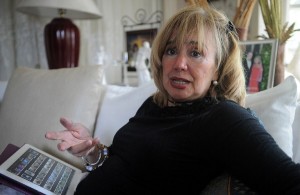
MANILA, Philippines—Cynthia Carrion-Norton flits high-heeled around Metro Manila with energy levels belying her years, thankful for a controversial treatment she highly recommends to fellow 60-somethings.
Carrion-Norton, 66, a member of the Philippine Olympic Committee and a former undersecretary for medical tourism, credits her vitality to adult stem cell therapy.
“The day I got the therapy I went to a dinner party and everyone told me: ‘Cynthia, you’re blooming!’” she told Agence France-Presse (AFP).
The procedure involves harvesting the patients’ stem cells from their own fat and injecting them into their blood, which she likened to being injected with intravenous fluid in the arm.
In a country where the elite are obsessed with anti-aging, wealthy Filipinos are shelling out between $12,500 (about P540,000) and $18,000 (about P780,000) per session of stem cell therapy in the belief it will improve their overall health and make them look younger.
Public officials
Rich businessmen and public officials—mostly male—are the most eager customers, according to Florencio Lucero, a doctor in Manila who said he started performing adult stem cell therapy in 2006.
“They do it because they want to work longer,” Lucero told AFP. “And then they tell their wives or girlfriends.”
Lucero said Filipinos had been receiving anti-aging stem cell treatment since the 1970s, often flying abroad to do so.
Thai medical entrepreneur Bobby Kittichaiwong says he has a lucrative business catering to the Filipino elite, who pay $20,000 (about P864,000) to visit his Villa Medica clinic in Germany for a more controversial form of stem cell therapy.
Estrada, clinic in Germany
The clinic harvests cells from unborn sheep to be injected into a patient’s muscles, known as fresh cell therapy, and Kittichaiwong said 400 Filipinos visited last year.
“After 14 days, the patient’s skin will glow and their digestive and immune systems will improve,” he said.
Among Villa Medica’s high-profile clients is former President Joseph Estrada, 76, who has staged a remarkable political comeback in recent years after being forced to stand down from the nation’s top job in 2001 because of corruption.
“Now I sleep better. My knees are no longer a problem. My skin has been radiant like this ever since,” a testimonial from Estrada reads in a Villa Medica brochure.
A spokesperson for Estrada, who was this year elected mayor of Manila, confirmed he had stem cell therapy treatment at Villa Medica.
Enrile, too
Another remarkable, elderly politician who has cited stem cell therapy as one reason for his enduring career is 89-year-old Sen. Juan Ponce Enrile, who was defense minister during the reign of dictator Ferdinand Marcos a generation ago.
Villa Medica also cites Enrile as one of its patients.
However, the use of stem cells from sheep has attracted much criticism, with Samuel Bernal, a professor of medicine at the University of California, among the many Filipino doctors to warn of its dangers.
‘Could be fatal’
“When animal cells are transmitted to humans, it could be fatal,” Bernal said at a recent forum on stem cell therapy in Manila.
Kittichaiwong insists fresh cell therapy is perfectly safe.
“What you eat every day is foreign material, but you don’t get rejection,” he said, adding that Villa Medica planned to soon open a clinic in the Philippines.
Amid this debate, Carrion-Norton wants to promote the less controversial adult stem cell therapy in the Philippines, and set up her own clinic.
“I don’t want only the rich to be able to do it,” she said. “I want everyone that needs it to be able to do stem cell therapy, because this is the medicine of the future.” However, treatments at Norton’s clinic will start at about $17,000 (about P734,000).
“It’s still expensive and will remain so unless a lot of people get into the business,” she said. “That’s why I want more people to know about it and not be afraid of it.”
Stem cell therapy for health and cosmetic purposes is popular in China, India and many other Asian countries. However, like the Philippines, laws and enforcement, in large part, have yet to catch up with the medical advances.
Regulation
The Department of Health is scrambling to regulate local stem cell therapy practices amid a chaotic and often dubious boom in the industry.
In an effort to tap into the much larger markets of the country’s lower and middle classes, advertisements for more affordable products and treatments claiming to use stem cells have been springing up.
Stem cell pills
Stem cell pills claiming to make customers “feel and look at least seven years younger” can be bought through Filipino websites for just P9,000.
Cheap and top-end beauty centers also offer a range of treatments, some not involving qualified health professionals.
Human stem cell procedures can indeed offer life-saving treatments for patients with leukemia, lymphoma and some solid tumors, according to the American Medical Association.
The US-based International Society for Stem Cell Research also said the procedures for human, or adult, stem cell therapy had “tremendous potential” for treating a range of human afflictions.
But it warned clinics around the world were offering “unproven treatments” for many illnesses that posed “very real risks of developing complications.”
Desperation of sick
The lack of regulations in the Philippines makes it an ideal setting for medical practitioners to “prey on the desperation of sick people,” said Dr. Anthony Leachon, vice president of the Philippine College of Physicians.
Health Secretary Enrique Ona said his department was planning to come up with a list of doctors and institutions accredited to practice stem cell therapy in the Philippines.
But the government is clearly eyeing the potential economic benefits of stem cell therapies.
“We look at this issue with a certain degree of liberty to make sure that our hospitals that are carrying out good stem cell therapy practices can continue them,” Ona said.
“Hopefully, in the future, the Philippines can even claim to be a center of stem cell therapy in this part of the world, if not even internationally.”









































